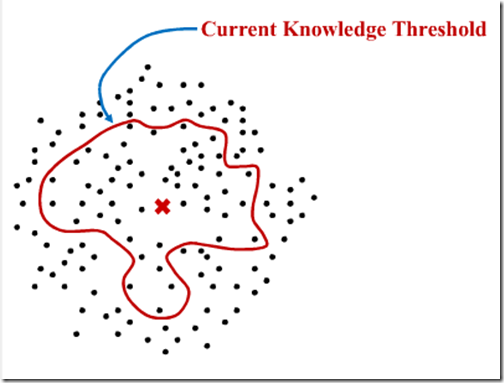One of the graphics in Bill Costantino’s presentation really struck me, but my thought was out of context so I wanted to make a separate post about it.
It was the concept of the “current knowledge threshold” illustrated here:
As I interpret it, the red line depicts the “we know how to do this” area. It is the domain where the team is comfortable working, they have a good grasp of cause and effect.
For problems which are outside the red line, the organization needs to engage in deliberate activity to gain understanding, to push the boundary of knowledge until the problem is enclosed by it. I tried to illustrate that process at the end of the original post.
Sadly, this doesn’t happen often enough.
Instead what happens is the organization develops a comfort zone inside the red line. Things that are outside the red line come labeled with “That doesn’t work here” and “We have reached the limit of what we can improve.”
Organizations, even sub-organizations within the same company that out-perform the baseline knowledge – who have cracked problems outside the red line – get dismissed as “no different” or “nothing special” or are attributed with special, unrepeatable, circumstances to account for their different performance. (I have seen this up close.)
If you are serious about kaizen, it is important to be operating right at the edge of the red line.
“What have we done today that, yesterday, we didn’t know how to do?”
“What will we try tomorrow that, today, we don’t know how to do?”
Those are questions that push learning.
By the way – if you are spending all of your time inside the red line, and solving the same problems again and again, your performance is likely flat lined. This is the “improvement plateau.” That is another topic for later.

Furthermore, the point that Costantino tries to convey is there are several directions and “wastes” within our comfort zone that we can attack. Many of us do just that: See waste, eliminate waste. This shotgun approach can inevitably lead to addtional waste and taking the organization in several different directions. The organization needs to eliminate waste in consideration of their vision or targets. So work at the edge or just beyond the red line, but do so in the proper direction.
Great post and additional clarification. Jeff great comment and in line with your comment is how often do we see people working on a process for waste elimination that is not a bottleneck to there process or value stream as well as not even knowing where there bottlenecks exist.